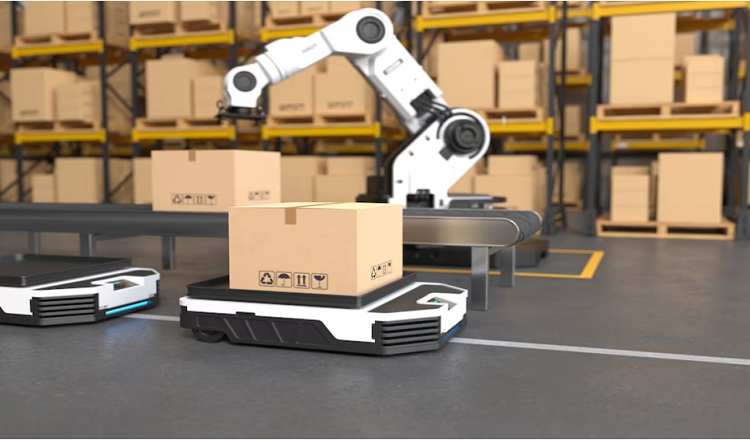As the world becomes increasingly automated, it’s no surprise that robots have found their way into the logistics and supply chain management industry. Robotics has emerged as a game-changer for businesses looking to streamline their operations and improve their bottom line. From automated guided vehicles (AGVs) to drones, robotic technology has revolutionized the way goods are transported and delivered. In this article, we’ll take a closer look at the use of robotics in logistics and supply chain management, examining its definition, importance, and benefits.
Robotics in logistics and supply chain management refer to the use of automated machines to manage and execute tasks such as storage, transport, and delivery of goods. This technology involves the integration of hardware and software, allowing machines to function autonomously, without the need for human intervention. The use of robotics in logistics and supply chain management has gained traction in recent years, owing to the numerous benefits it offers.
One of the key advantages of robotics in logistics and supply chain management is increased efficiency. With robots performing repetitive tasks such as palletizing, packaging, and loading and unloading goods, businesses can save time and money by reducing the need for manual labor. Additionally, robots offer enhanced accuracy, reducing the risk of human error, and can operate around the clock, improving the speed and reliability of deliveries. In this article, we’ll delve deeper into the benefits of robotics in logistics and supply chain management, explore the types of robots used in the industry, and examine the challenges and future of this technology. So, let’s get started!
Benefits of Robotics in Logistics and Supply Chain Management
Robotics has brought a multitude of benefits to the logistics and supply chain management industry. One of the key advantages is the increased efficiency that robots offer. With their ability to work around the clock, without the need for rest or breaks, they can accomplish tasks at a faster pace than humans. This results in faster turnaround times, reduced lead times, and improved productivity. Additionally, the use of robots offers enhanced accuracy, reducing the risk of human error, which can have a significant impact on quality control and customer satisfaction.
Cost reduction is another benefit of using robotics in logistics and supply chain management. By automating manual tasks such as palletizing and loading and unloading goods, businesses can reduce their reliance on human labor, which can be costly and require additional training and management. Moreover, robots can operate on a predictable and consistent schedule, eliminating the need for overtime pay and reducing the risk of workplace injuries. Improved safety is also a significant advantage of using robots in the industry. By handling hazardous or heavy loads, robots can reduce the risk of workplace accidents and injuries, ultimately creating a safer working environment for employees.
Types of Robotics used in Logistics and Supply Chain Management
There are several types of robotics that are used in logistics and supply chain management. One of the most popular is the Automated Guided Vehicles (AGVs), which are mobile robots that can autonomously navigate and transport goods within a warehouse or facility. These vehicles are highly versatile and can be programmed to handle various tasks, such as storage, retrieval, and transportation.
Drones are another type of robotic technology that is gaining traction in the industry. These unmanned aerial vehicles can be used to deliver goods to remote or hard-to-reach locations, offering a cost-effective and efficient alternative to traditional delivery methods.
Robotic arms are another common type of robotics used in logistics and supply chain management. These machines are designed to handle repetitive and labor-intensive tasks, such as palletizing, loading and unloading, and sorting.
Exoskeletons are another emerging technology that has the potential to revolutionize the industry. These wearable machines can assist workers in lifting heavy objects, reducing the risk of workplace injuries and increasing productivity. Overall, the use of these different types of robotics in logistics and supply chain management is transforming the industry, increasing efficiency, reducing costs, and improving safety.
Case Studies on the Use of Robotics in Logistics and Supply Chain
Several companies have embraced the use of robotics in logistics and supply chain management, resulting in significant improvements in efficiency, accuracy, and cost reduction. Amazon is one such company that has made substantial investments in robotics, using AGVs and drones to streamline its operations and improve its delivery times. Similarly, Alibaba has implemented a highly automated warehouse system, using robotic arms to process and sort packages.
DHL has also adopted robotic technology, utilizing AGVs to transport goods within their warehouses and sorting centers. These vehicles can handle heavy loads and operate on a 24/7 basis, reducing the need for human intervention and improving productivity. FedEx has also integrated robotics into its operations, using drones to deliver packages to remote locations, reducing delivery times and costs.
The use of robotics in logistics and supply chain management has proven to be a game-changer for these companies, improving their bottom line and enhancing the customer experience. As this technology continues to advance, we can expect to see more companies adopt it and reap the benefits.
Future of Robotics in Logistics and Supply Chain Management
The future of robotics in logistics and supply chain management is promising, with advancements in artificial intelligence and machine learning opening up new possibilities for the industry. These technologies can enable robots to perform more complex tasks, such as decision-making and problem-solving, which were previously only possible for human workers.
Furthermore, there is an increased focus on the integration of robotics and the human workforce, with the goal of creating a more efficient and productive environment. By combining the strengths of both humans and robots, businesses can achieve optimal results, with robots handling repetitive tasks and humans focusing on more complex and strategic work.
The potential for new applications is also significant, with the development of new types of robots that can handle a wider range of tasks and environments. This includes the use of drones for last-mile delivery, exoskeletons for warehouse workers, and even autonomous trucks for transportation. As the technology continues to evolve, we can expect to see further advancements in the use of robotics in logistics and supply chain management
Challenges in Implementing Robotics in Logistics and Supply Chain Management
While the benefits of using robotics in logistics and supply chain management are clear, there are also several challenges that come with implementing this technology. One of the main obstacles is the high initial investment required to purchase and install robotic systems, which can be a significant barrier for smaller businesses. Additionally, maintenance and upgrades can be costly and require skilled technicians, adding to the overall cost.
Limited flexibility is another challenge, as robotic systems are designed for specific tasks and may not be adaptable to changing circumstances. This lack of flexibility can limit the ability of businesses to respond to sudden changes in demand or unexpected events.
Another major concern is the potential for job loss as robots replace human workers. While this may result in cost savings, it can also have a negative impact on communities and the overall economy. To address this concern, companies must consider the ethical implications of their decisions and find ways to reskill and retrain their workforce to meet the changing needs of the industry.
Conclusion
In summary, robotics technology has played a significant role in the evolution of manufacturing, from the first industrial robots to modern-day automation, and it continues to be a key technology driving the transformation of the industry in the era of Industry 4.0. The combination of robotics, the Internet of Things (IoT), and artificial intelligence (AI) has created a more efficient, connected, and automated manufacturing environment, with numerous benefits including increased efficiency, productivity, and quality, as well as improved worker safety.
Emerging trends in robotics such as cobots, mobile robots, and swarm robotics, are revolutionizing the manufacturing industry, providing new opportunities for innovation and transformation. However, there are also challenges associated with implementing robotics in manufacturing, such as cost, complexity, and the need for skilled workers.
The potential impact of robotics on the industry is significant, as the technology continues to advance and become more accessible. Robotics technology has the potential to create a more sustainable, adaptable, and competitive manufacturing environment, paving the way for new opportunities and economic growth. Overall, robotics technology will play a vital role in the future of manufacturing, and its continued development and implementation will be critical for the industry to remain competitive and thrive in the years to come.




